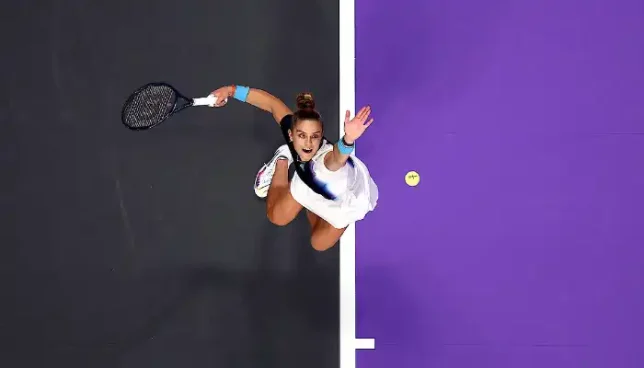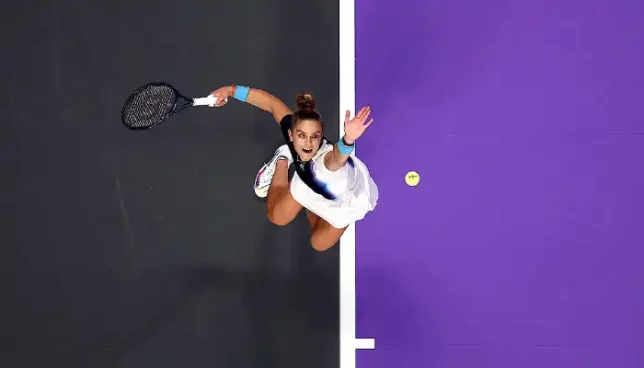Tennis has been captivating people for centuries with its history, athleticism, and beauty. It is a game for all ages and abilities; a good game of parrying can be enjoyed by anyone. When struck perfectly, the ball creates a satisfying thwack; when placed correctly over the net, it brings joy; outsmarting an opponent is fun because it tests mental ability; these are among the reasons why tennis remains so popular.
This manual seeks to provide everything you need as an eager beginner about to embark on your tennis journey. Whether you want to have fun with friends or aim for Wimbledon one day, this guide will help you succeed on the court.

Preparing For Greatness: What You Will Need
However, there are a few things you must do before entering any court. Here they come:
- Racket: Your trusty weapon! As a beginner, use a mid-sized racket with a larger head size that offers more forgiveness elsewhere than where center hits occur. Go for lighter rackets (around 270–290 grams), as they are easier to handle.
- Balls: For recreational play, use regular pressure balls. There also exist high-altitude balls that travel slower if one decides to play outside when it’s windy.
- Shoes: Court shoes should provide good lateral support and traction across different surfaces of courts, so invest wisely.
- Attire: Comfortable clothing is what matters most! Choose breathable materials that wick away moisture and allow free movement.
Finding Your Court: Where To Start Playing
Now that you have everything you need, it’s time to find the ideal location for the game. Here are different options:
- Public Tennis Courts: Several parks and recreation centers offer public tennis courts for free or at a low cost. This is ideal if you just want a casual place where you can practice your stroke without much hassle.
- Tennis Clubs: Joining such clubs guarantees access to well-maintained courts as well as group lessons and hitting partners who are likely to be available most of the time.
- Home Court Setup: If there’s enough space at home, setting up a court with a portable net offers the ultimate convenience, allowing one to practice alone or with others whenever they want.
Building a Solid Base: Getting the Basics Right
Tennis may seem simple, but achieving good, solid basic strokes requires focus and repetition. Here are a few points to consider:
- Grip: How you hold the racket goes a long way in determining how much control or power you will have over your shots. There are three main grip types used in tennis: continental, eastern, and western. Start with a continental grip, which is considered more versatile, especially for beginners.
- Stance: To generate power and respond quickly to an opponent’s shots, one must maintain a balanced, stable stance throughout the game. Slightly bend your knees while keeping your weight evenly distributed on both feet.
- Key Strokes:
- Forehand: This stroke should be hit using the dominant hand on the same side of the body as hitting the arm.
- Backhand: A non-dominant hand hits this shot; though harder to master than forehand due to its versatility, when mastered, it greatly enhances control of ball flight direction across the court, etc., making games more interesting.
- Serve: Technique is everything here. You must start the game with a strong and accurate serve.
- Volley: It’s hitting before the ball bounces. This skill includes valuable net play skills, such as lobbing an opponent high and robbing them of the chance to regain balance before another shot comes their way, thus turning it into an overhead smash instead.
- Overhead Smash: It’s a powerful finisher point that can be won either through forcing defensive errors on opponents or simply landing beyond reach, thereby causing frustration among them and thus giving them an advantage over them mentally too.
Hone Your Skills: Tips for Improvement
This needs consistency and fundamentals that are mastered over time. Here is how you can speed up your improvement:
- Be Consistent: Use practice drills that make you hit the ball in the same place every time or aim for a particular spot on the court.
- Build Strength and Agility: Add off-court exercises into your routine that focus on core strength, leg power, and overall agility. This will improve your game and help prevent injuries.
- Develop Strategy: Tennis is not just physical; it’s a mental game too. Learn about shot selection (when to use what kind of shot) and court positioning so you know where to be when your opponent hits the ball.
Mastering the Mental Game
The court may be where physical battles occur, but mental toughness often separates winners from losers. Here’s how to develop an ironclad mind:
- Stay Focused: Tennis requires intense concentration. Use mindfulness meditation or controlled breathing at points to stay present and shut out distractions. Imagine making every return and predicting where their shots will go next.
- Control Your Emotions: Anger, nerves, pressure—these feelings are normal, but they ruin games if left unchecked! Recognize them without dwelling on them; use positive self-talk or breath control as coping mechanisms to keep calm.
- See Yourself Winning: There’s no denying the power of mental imagery. Before matches, close your eyes and visualize hitting perfect shots, moving around the court confidently, and celebrating victories. This kind of “rehearsal” builds self-assurance and programs success into muscle memory.
Advancing Your Skills on the Court
Several areas require improvement to become a complete tennis player. Here are some suggestions for improvement:
- Get Coaching Help: A good coach will spot weaknesses, correct techniques, and devise training plans tailored specifically for you. Their feedback during lessons is invaluable in building a strong foundation and eliminating bad habits from your game.
- Participate in Tournaments: Push yourself beyond your comfort zone by taking part in local tournaments, leagues, or ladder matches. This will test your skills under pressure, expose you to different styles of play, and allow you to reflect on your wins and losses, identifying areas that require further improvement.
- Never Stop Learning: Tennis is dynamic with constantly evolving trends, so stay updated by attending clinics, watching instructional videos, or reading articles by professionals about new strategies, techniques, and training methods.
Conquering Challenges: The Road to Resilience
Becoming excellent at tennis is not a simple task; there will be challenges. Here’s what to do when you have setbacks:
- Avoiding Injuries: Pay attention to your body! Warm up properly before playing (and cool down afterwards), stretch regularly, and incorporate strength training into your routine; it can help prevent injuries. Rest until fully recovered if injured, and consult with a physician before returning to court.
- Finding Balance: Practice is key, but so is rest; overdoing it can lead to burnout or physical fatigue, which won’t improve performance either. Schedules should incorporate cross-training activities, healthy eating habits, and adequate sleep each night to ensure optimal results for both mind and body.
- Persistence During Plateaus: Sometimes progress feels slow or nonexistent, but don’t give up! Celebrate small wins, keep long-term goals visible, and remember why tennis makes life fun—this mindset encourages continued success over the years.
Becoming a Tennis Champion: Owning Your Journey
Real mastery of tennis involves more than just skill; adopt these mindsets to make yourself unstoppable:
- Setting Goals: Establish specific short-term and long-term objectives that are attainable. For example, set a short-term goal of becoming proficient at a certain stroke, or set a long-term goal of achieving a specific rating or winning local tournaments. This will motivate you by highlighting areas that require improvement.
- Celebrating Successes: Many people forget about rewarding themselves for their accomplishments. So let’s say you need to reward yourself, even though it may be small. For instance, you could consider purchasing a new racquet following your initial victory or mastering specific moves.
- Sharing the Love: Tennis is more than just hitting balls over nets—it’s about community! Share the game with others! Make friends by playing matches against new players, volunteering at local tournaments in your area, or creating blogs and social media accounts about what people love most about tennis.
Conclusion
You can never truly master tennis; with every milestone comes another defeat. Therefore, we should embrace every challenge, as enjoyment is essential! When we combine commitment, practice, and the right attitude, we can dominate baselines and realize our dreams! Therefore, now that we have everything we need, let’s go out confidently but always share these stories online so others can stay motivated while keeping our love for games alive everywhere.

